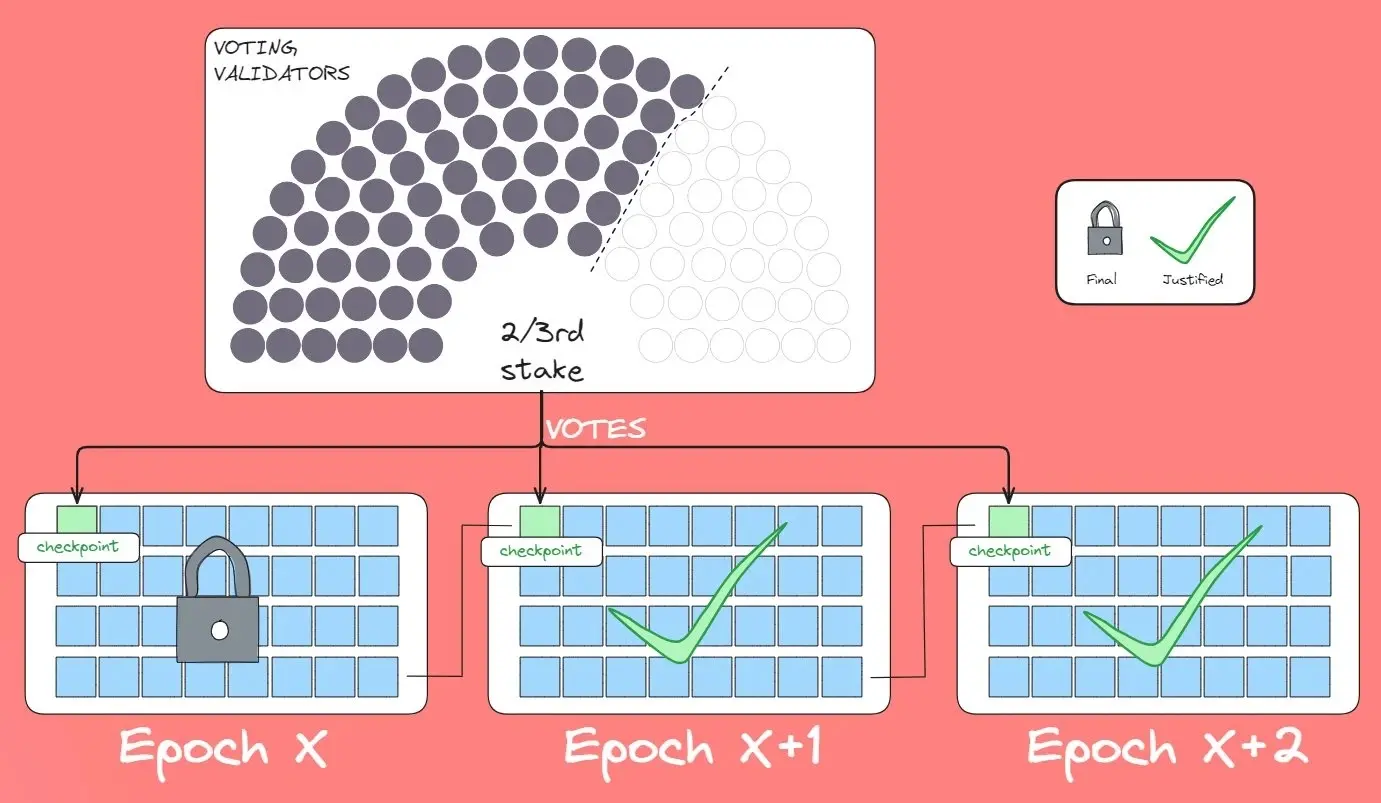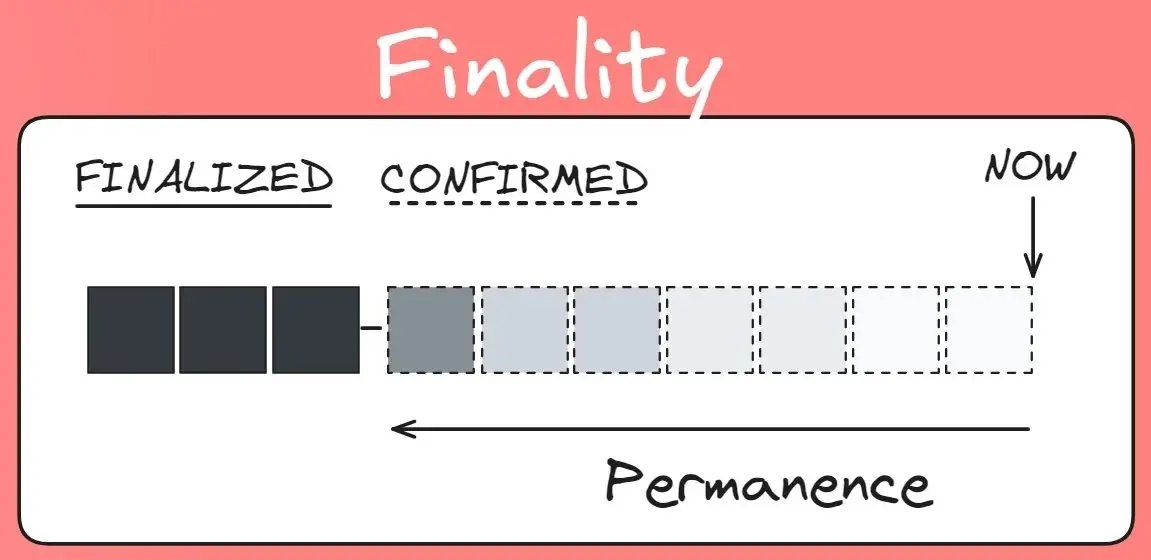What is the primary improvement Vitalik wants for block finality?
Author: BREAD
Compiled by: Golem, Odaily Planet Daily
Editor's Note: Ethereum founder Vitalik mentioned in his new article today, "Possible futures of the Ethereum protocol, part 1: The Merge," the areas where Ethereum's technology still needs improvement, along with the reasons and paths for these improvements. The primary focus is to change the block finality from 2-3 epochs (~15 minutes) to be completed within a single slot (~12 seconds). So, what exactly is finality, which Vitalik emphasizes so much? How is it achieved in Ethereum and L2?
Crypto researcher BREAD's article "WTF is Finality?" explains block finality and its implementation process through analogy. The Planet Daily has specially compiled it below, hoping to aid readers' understanding.
Analogizing Finality
In keeping with the tradition of my "WTF is…" series, I like to start with analogies from real life. If people are unwilling to delve into the underlying details, they can step back and grasp the key points. For finality, we can use the example of concrete hardening over time, as shown in the image:
This is the highest-level explanation of "finality" in blockchain. Just like concrete, over time, from pouring (initial confirmation) to setting (multiple confirmations), it becomes increasingly difficult to deem the initial block as "fake" until it fully hardens (finalized). Once it reaches the end, it is almost impossible to change.

The corresponding specific sequence in blockchain is:
Submitted > Confirmed > Finalized
If you want to delve deeper into the methods, content, and reasons for finality (in the Ethereum environment), feel free to continue reading.
What is Finality?
Let's try to understand some structure around this concept. Here is an explanation of finality and related concepts:
- Slot (also known as block time): Perhaps its alternative name, block time, is easier to understand. A slot or block time is the amount of time allocated to the system to generate new transaction blocks and attach them to the current chain. For example, Ethereum's slot is 12 seconds, Base is 2 seconds, and Solana is 0.4 seconds.
- Confirmation: Confirmation occurs when a transaction is officially added to a block that has been added to the current chain. It is now "confirmed" as part of the ledger, and as subsequent blocks are continuously added to the ledger, the number of confirmations will increase.
- Epoch: Every 32 slots is called an epoch. This is a secondary structure in the blockchain used for delegating roles and responsibilities. Slots are used to build blocks, while epochs are used for data propagation, reward distribution, validator selection, etc.
- Checkpoint Block: A checkpoint block is the first block created in an epoch, serving as a reference point for checking the chain's history.
- Finality: Finality is the point at which a transaction is considered irreversibly added to the ledger of a given chain. However, in terms of technical attributes, the use of this term varies across chains, so it is best not to assume uniform standards in all cases. In the Ethereum ecosystem, finality is reached after 2 epochs (~13 minutes); in Optimistic L2, it requires waiting for the fraud dispute period to pass (~7 days); in ZK L2, due to the guarantees provided by validity proofs, there are two disputed finality moments: local (when proofs are generated on L2 [~a few minutes]) and global finality (when proofs are published to Ethereum and finalized there [~13 minutes]).
- Block Reorganization ("Reorg"): Block reorganization refers to blocks that were once confirmed as part of the chain but are no longer considered valid for some reason, resulting in the formation of a new chain. This usually comes with penalties.
The following image attempts to visualize all these terms in a single image to make them easier to understand:

How is Finality Achieved?
Now that we understand finality and related concepts, how do they collaborate? What are the rules?
For Ethereum
- Validator Voting: Validators for each epoch (32 blocks) will vote on the checkpoint blocks of the current and previous epochs until the checkpoint block receives 2/3 of the votes from staked ETH;
- Reasonable Checkpoint: Once the checkpoint block reaches the 2/3 voting threshold, it is considered "reasonable";
- Absolute Majority Chain: Once two subsequent checkpoint blocks a and b are both reasonable and b has connected to the next block, the blocks included in the epoch prior to the first epoch will become final blocks, and they will no longer be affected by simple block reorganization.

For L2
L2 is built on Ethereum, so are they basically the same?
The answer can be both yes and no. In "The Future of Ethereum, Will Based Rollups Have a Place?" it was mentioned that L2 is an independent blockchain, but they rely on Ethereum for finality settlement. This means their finality is layered just like the chain.
There are two types:
- Local Finality: This is the finality of L2 itself and applies only to L2s that utilize validity proofs (also known as ZK Rollups). This is because validity proofs are mathematically supported, and when the proof itself is generated, it means it is correct. Therefore, once a ZK L2 generates its proof, the L2 state can be considered finalized without waiting for the proof to be published to Ethereum and settled there. However, this still carries risks and trust assumptions, which can be judged based on one's risk tolerance.
- Global Finality: Once the state is determined, L2 confirms its local state and generates a proof (fraud or validity), publishes that proof to Ethereum, and then Ethereum confirms the block containing that proof. Even so, for L2s using optimistic methods, there is still an opportunity to revert transactions until the 7-day challenge period has passed. This is a trade-off made to reduce the computational load required for proof creation.
L2 networks can have local finality in certain cases, but generally, they must wait until Ethereum completes its published validity proof (ZK) or the challenge window for fraud proofs has passed (Optimistic rollups).
For Bitcoin / PoW Chains
In Bitcoin's PoW mechanism, there is no concept of finality because anyone can produce the longest chain and become the main ledger. This means that, although somewhat unrealistic, as long as there is enough computing power, one can rewrite Bitcoin's history from the last day, week, or year.
However, although this approach is costly in terms of resources and time and is impractical in operation, it does create a meaningful distinction between different systems and gives rise to several unique types of MEV (Maximum Extractable Value), such as "Long-Ranged Attacks" and "Block Withholding." In these cases, miners can choose to produce and hide a block and then append a subsequent block or mine multiple blocks in succession, thereby creating and capturing unique profit opportunities.

Why is Finality Needed?
From the above, we know how finality is achieved in PoS chains, and it requires a significant amount of work. So why do we do this? The answer is that there are indeed some benefits to doing so:
- Economic Security: The system (and we) can review a certain point and confidently assert that it will not change, giving ecosystem participants confidence in the "real situation." For example, large transfers and loans, once users are confident that the system cannot change without extreme, protocol-exceeding interventions, will encourage users to participate in the ecosystem based on this authenticity. This is also why cross-chain bridges often wait for a certain number of confirmations or complete finality before releasing funds on secondary chains.
- Faster Settlement: Because there is a moment in the system that formally establishes the state as permanent, this means that participants within the ecosystem only need to wait for this settlement time, whereas in PoW systems, this moment never arrives and is entirely dependent on individual subjective judgment.
- Reducing Attack Factors: The previous section mentioned some MEV opportunities present on PoW chains. PoW chains only address the "Nothing at Stake" problem, meaning that anyone taking malicious actions against the system may also face losses. However, in PoS chains, if you are a validator and attempt to change a finalized state, you must violate protocol rules, thus facing the risk of slashing.
Conclusion
This article briefly explains what finality is, aiming to make people aware that it is a frequently used but often misunderstood mechanism in blockchain. The process of finality is like blocks in the system hardening like concrete, and ultimately they become as solid as a rock.











